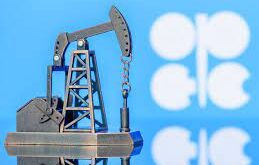Oil demand growth is set to slow in the coming months, with consumers likely to endure high prices until consumption is brought back into line with supply that’s struggling to keep pace with the world’s thirst for fuels.
The International Energy Agency, the US Energy Information Administration and the Organization of Petroleum Exporting Countries all see global oil demand growth falling back after a strong performance in the opening quarter of the year. But the Paris-based IEA is the only one to see growth flipping to shrinkage, and then only in the final quarter of the year. Even then, the drop is very modest at just 390,000 barrels a day compared with the same period in 2021.
The EIA sees demand growth getting weaker quarter by quarter, but remaining positive throughout the year. OPEC takes a much more bullish view. While demand growth halves between the first and second quarters, the oil producers’ group expects that consumption will continue to increase year-on-year by more than 2 million barrels a day throughout the remainder of 2022, even in a world that looks likely to face persistently high end-user prices.
Of the three agencies, OPEC is the only one that sees global oil demand back at its pre-pandemic level in 2022. Annual average demand forecasts from the IEA and EIA both see consumption this year lagging behind 2019 by about 1 million barrels a day.
Within the global totals, one important difference emerges. While OPEC sees Chinese demand increasing by 2% this year, the IEA sees it going in the opposite direction, shrinking by 1% in the face of rolling lockdowns as the country prioritizes a zero-Covid policy over the economy. There is much closer agreement in other areas, with both the IEA and OPEC seeing India’s demand increasing by 6% to 7% and that of the countries of the former Soviet Union, dominated by Russia, contracting by about 4%.
Supplies are struggling to keep pace with demand. The IEA sees total non-OPEC output sharply down in the second quarter, compared with the first, with an increase in the US more than offset by a drop in Russian output and a decline in production by the other non-OPEC countries — largely the result of a stoppage at the CPC export terminal used by Kazakhstan and a subsequent closure of its second-biggest producer for planned maintenance at the start of June.
Production growth should recover in the third quarter, with higher output expected from Kazakhstan, continued growth in the US and only a small drop in Russian production. That all changes in the fourth quarter, when Russian production is seen falling sharply, probably triggered by the implementation of EU sanctions on its seaborne crude exports which are due to come into force in December. The slump in Russian oil production outweighs slowing, but still positive, growth in the rest of the non-OPEC world.
By this time, the OPEC+ output agreement, which has overseen the slow return of more than 10 million barrels a day of supply removed at the height of the pandemic in early 2020, will have come to an end. Producers have not yet decided what they will do after August, when the final barrels will be added back to individual output targets. Most members are already producing at, or close to, their capacity levels and the group as a whole is falling further behind its overall output target each month. The 10 OPEC countries that are part of the deal were pumping almost 1.1 million barrels below their combined target of 25.589 million barrels a day in May, according to figures from the group.
Forecasters are also struggling to get to grips with Russian oil production. OPEC has reduced its outlook for the country, cutting average 2022 production by 250,000 barrels a day from its previous forecast. It now sees output falling year-on-year by 200,000 barrels a day. That’s modest when put alongside the IEA’s forecast, but the group does warn that it’s “subject to high uncertainty.”
Having initially seen a big hit to Russian production from consumer reactions to its invasion of Ukraine, the IEA is now rolling back the deep cuts it saw in its earlier forecasts. The sharp drop in production of about 3 million barrels a day that it saw back in March has been replaced with a more gradual choking off of some supply. It now sees Russian production falling to 9.38 million barrels a day by the fourth quarter and dropping further in early 2023. Moscow’s ability to divert seaborne crude exports to India has helped it to maintain production levels in the face of self-sanctioning of its oil by former European buyers.
But Russian production is coming down. OPEC puts the drop at 964,000 barrels a day between March and April, followed by a small rebound of 152,000 barrels a day in May. The IEA sees a similar pattern.
That falling supply, in an environment of continued demand growth, is keeping upward pressure on oil prices and that is likely to continue until they rise high enough to choke off demand growth and perhaps even send it into reverse.

 Iran Energy News Oil, Gas, Petrochemical and Energy Field Specialized Channel
Iran Energy News Oil, Gas, Petrochemical and Energy Field Specialized Channel



